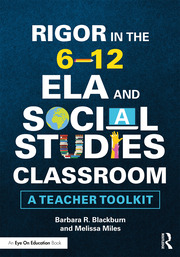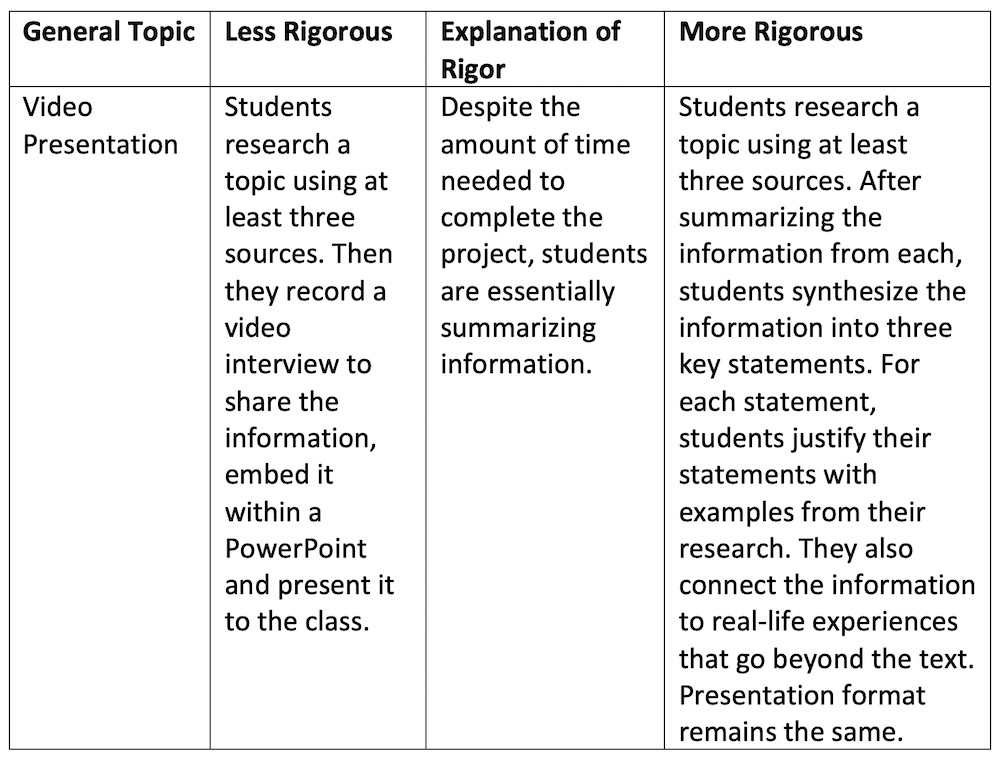How We Can Assure Rigor in Our Lessons
By Barbara R. Blackburn

One of the challenges when incorporating rigor in the classroom is determining what that rigor looks like. For example, many teachers share with me that they know their students should “create” something, which is high level on Bloom’s Taxonomy.
But there is a difference in creating a plan for a robotic arm to meet a need in our society and creating a booklet of pictures of robots. We need more than verbs to determine the characteristics of rigor.
In my years of work, I’ve found that we can look at a variety of frameworks, including Bloom’s Taxonomy, Webb’s Depth of Knowledge, and the Cognitive Rigor Matrices to help us understand how to increase rigor in our classrooms.
Based on my work with these frameworks and my own research, I’ve found that we should look at criteria such as recognizing and explaining mistakes, demonstrating an understanding of text while moving beyond the text, looking for patterns across time and themes, and justifying statements based on evidence.
Let’s look at examples of rigorous tasks, beginning with a comparison of a task at a less rigorous level, then at a more rigorous level.
Rigor in Social Studies
Next, let’s look at an example of a social studies lesson that would be used over a longer period of time. Notice the higher levels of analysis that are required to complete the project.
As a class, brainstorm social issues that might be taken up by special-interest groups. The list might include areas such as lessening opioid addiction, protecting animals from research, increasing school funding, etc. Discuss what makes a special-interest group (events, legislative actions, non-profit status, etc.), and introduce and discuss a sample special interest group and how it works.
Divide students into small groups. Each group selects an issue and researches the positions of the two major presidential candidates on this issue. Students should also research the special-interest groups that have formed around this issue, noting their size, their constituency, and their messages and activities during the primaries or recent elections.
Next, students form their own special interest group. They must develop an agenda to promote their interest, arguments for their goals, and arguments against possible opposition points.
Students must include a written rationale for their position that addresses the above points. It must include specific factual evidence from two to three credible sources. Finally, students create a two-to-four-minute persuasive infomercial advocating for their point of view. It should include real-life examples of how the issue affects people’s lives, as well as how supporting their issue is a solution to actual problems.
Rigor in Math

Review the three linear equations, each of which represent a real-life situation, as well as their solutions. Determine which, if any, of the solved problems are incorrect. If there is an equation that is solved incorrectly, justify why it is incorrect, solve it correctly, and explain how you know it is now correct.
Rigor in Electives
I often hear that we cannot incorporate rigor in electives or related arts classes. As you will see from the example below, it is actually quite possible to build on experiences in art and music to give students an opportunity to critique a performance or piece of art. As you read the task, you’ll see how students are not simply giving their opinion; they are documenting it. Their opinion must be based on lessons learned and their own experiences.
The student listens/views a performance of their choice (either their own or one on the internet). Each student writes a short critique, which must include the student’s opinion of the work, support of the opinion based on the lessons taught by the teacher and the student’s own experiences, and recommendations for improvement.
Rigor in ELA
Writing is an integral part of an English/Language Arts classroom. In this sample, students must develop a logical argument, which can be on a topic of their choice. Again, students are not simply stating their opinion; opinions are based on specific evidence.
Choose a controversial issue of interest to you. Use credible sources to research the various perspectives surrounding the topic. Based on the information you’ve learned, explain two or more possible solutions to the controversy that would address the key aspects of the issue.
Finally, write a logical argument that contains a proposal/compromise to satisfy groups on both sides of the conflict. In your argument, be sure to explain how you will address the problem and justify your solution with logic and evidence from research.
Rigor in Science
Finally, in a science classroom, instead of simply describing catastrophic events, we can create a more rigorous task by incorporating research, predictions, justification, and moving beyond the text.
Using their knowledge of past catastrophic events that have affected the Earth and life on earth such as earthquakes, volcanic eruptions, weather devastations and asteroid contact, students must predict the next catastrophic event that is likely to occur.
They must base their prediction on research from a minimum of three sources other than the classroom text. Additionally, they must justify their prediction using their research and real-life examples and then provide information as to how, if at all, people could prevent or lessen the effects of the catastrophe.
A Final Note
Incorporating additional aspects of rigorous work in our classrooms is critical to preparing our students for the future. Understanding what rigor “looks like” can help us revise and create tasks that challenge students at a higher level.
Feature image: Asteroid above Earth (NASA/Bigstock)

A nationally recognized expert in the areas of rigor and motivation, she collaborates with schools and districts for professional development. Barbara can be reached through her website or her blog. Follow her on Twitter @BarbBlackburn.





































Barbara, thank you for giving such clear examples of what rigor can look like in various disciplines. I have been thinking a lot lately about how conceptual rigor can appear more consistently in mine and others’ classrooms. Your social studies lesson is somewhat similar to a campaign I’ve asked students to do in the past, described here: https://www.middleweb.com/43302/a-reformers-unit-that-celebrates-courage/. Hope your school year starts off well!